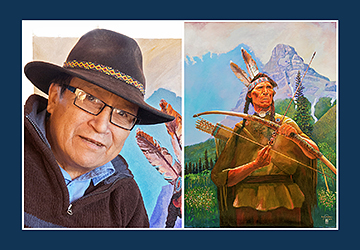Rollinmud painting recalls lesson at grandfather’s side
COFFEE WITH WARREN, with Warren Harbeck
Cochrane Eagle, February 27, 2014

Morley artist Roland Rollinmud celebrates the legacy of his late grandfather John Hunter in this 36 x 48-inch oil on canvas, “The Spirit of the Bow and Arrow.”
Photos by Warren Harbeck
Click to view a larger version
Morley artist Roland Rollinmud has a special fondness for his late grandfather John Hunter, 1874–1970 (known in his Stoney Nakoda language as Ûbi-thka Îyodâge, “Sitting Eagle”). “He was a man of wisdom, skillful in hunting and fishing, and a gifted educator,” Roland says.
Roland’s latest painting, “The Spirit of the Bow and Arrow,” celebrates a formative learning moment at his grandfather’s side. The subject? What making a bow and arrows can teach about self-reliance, craftsmanship and patience.
That lesson is detailed in a yet-to-be-published book by Roland on his life and art, written in collaboration with wellness author Jan Gale, of Cochrane. Here’s how they tell that story:
It all began at dinner one evening when Roland told his grandpa how he wished he had his own bow and arrows, just like the toy ones some of his friends had.
Grandpa thought it was a great idea, and suggested they make a set – but they’d make them in the old style, and they wouldn’t be just for playing games with the other boys.
They spent the next day searching for just the right limb from a birch tree – five feet long and four inches thick. They dragged the limb to a creek where it would stay submerged for a whole week – to “soften the wood and make it workable,” Grandpa explained.
“But why so long?” Roland asked, hoping to have something to show his friends right away.
“Something that is good will never give you problems,” Grandpa responded. “Be patient!”
In the copy of their manuscript Jan shared with me, she describes what happened next:
“Roland thought he would not be able to wait until the week’s end. On the day that the wood was to be taken out of the water, Roland ran ahead of Grandpa to pull out the birch limb. It was heavy and soaked, and very difficult to lift.
“It took another week to work the wood. Grandpa said that the ancestors used flint to work the wood into the basic shape. It was challenging and time consuming, but the hard work of those ancestors carved reverence for all life into the sacred bows! Grandpa now used a farrier’s knife, which still seemed to take a very long time in the mind of a small boy, but he sat patiently watching the skilled hands of his elder. The tree now looked like a bow.”
Then came more soaking, while they located five straight three-to-four-foot-long saskatoon stems for arrows and prepared them over the next few days. They also made a bowstring out of elk sinew, strung the bow, and made other preparations.
“All the while, Grandpa told stories and related the wisdom of the craft.”
Finally they were done. After many days working side-by-side, Grandpa turned to his grandson and said, “You and the bow know each other.”
Roland, 63 now and a grandfather in his own right, attributes his lifelong respect for Nature’s University and the traditions of his people to the influence of his grandfather and other elders.
In the spirit of his grandfather’s lesson of the bow and arrows, Roland, too, wants “to leave a legacy to the community about how important life is,” he says.
He thinks often of his grandfather’s words: “Use your life in a way that inspires the young people; use it wisely. Nîbi ne ahopam – respect life.”
© 2014 Warren Harbeck
JoinMe@coffeewithwarren.com